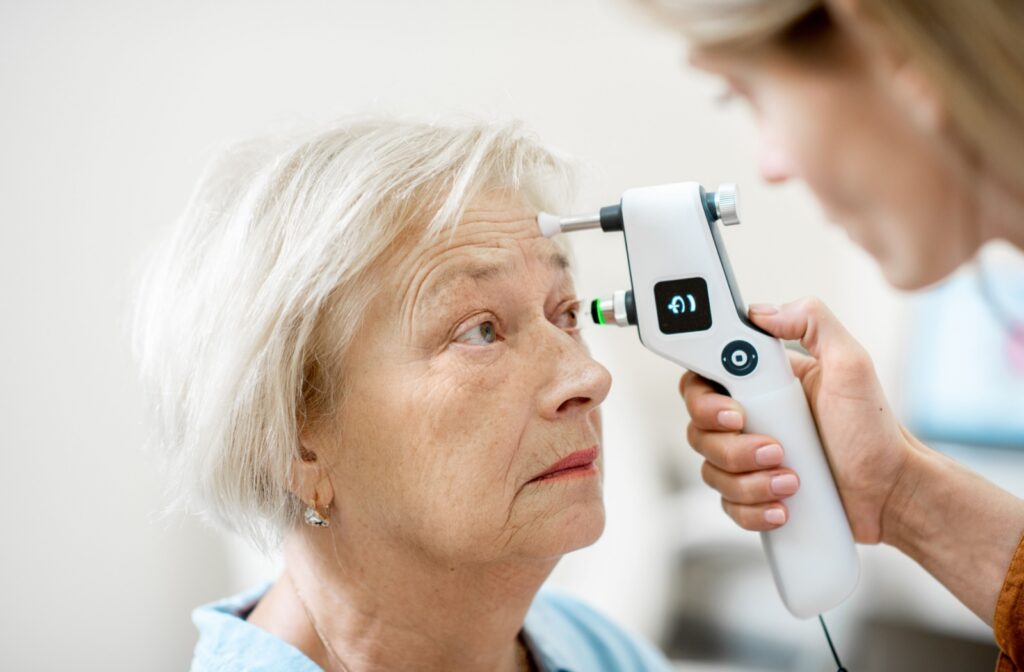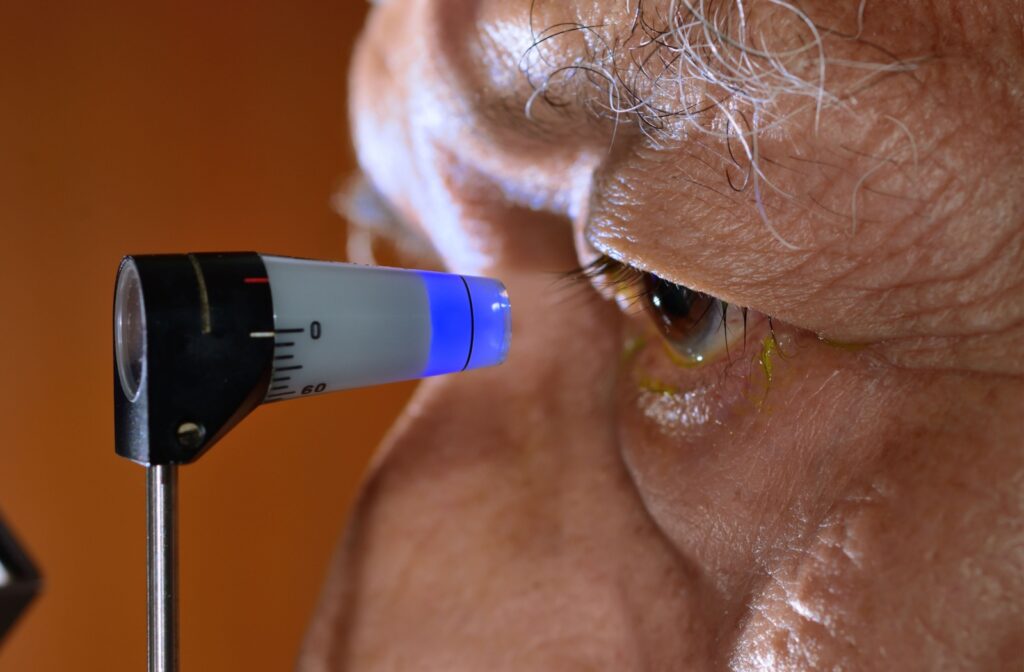Feeling pressure in your eye can be confusing and concerning. Could it just be a minor inconvenience, or is it an indicator of a more serious condition? You may have heard that eye pressure is linked to glaucoma, a serious eye disease that can threaten vision if left untreated.
However, glaucoma typically shows no symptoms in its early stages, and eye pressure associated with glaucoma cannot be felt. That’s why it’s important to have your eye pressure regularly checked by an optometrist. If you feel pressure behind your eyes, this sensation may have a wide range of causes, from headaches and sinus issues to dental problems or a damaged optic nerve.
What Is Eye Pressure?
Eye pressure, or intraocular pressure (IOP), refers to the fluid pressure inside your eyes. This pressure is a natural part of how your eye works, and under normal circumstances, your body regulates it by balancing the amount of fluid that it creates and disposes of. However, when this pressure becomes too high, it can pose risks to your optic nerve, potentially leading to serious eye conditions like glaucoma.
A normal eye pressure ranges between 10 mmHg and 20 mmHg (millimeters of mercury). Optometrists can measure eye pressure during routine eye exams using a process called tonometry, which determines how much force is required to flatten the cornea. This may involve a puff of air or other tool.
Causes of High Eye Pressure
High eye pressure, also known as ocular hypertension, can be caused by:
- A blocked drainage angle, which is where your iris meets the white part of your eye. This structure is responsible for draining out excess fluid.
- Overproduction of fluid
- A medication that produces high eye pressure as a side effect, such as corticosteroids
- An injury to the eye
Symptoms of High Eye Pressure
High eye pressure typically does not cause symptoms. That’s why regular eye exams that measure eye pressure are so important. The American Optometric Association recommends the following eye exam frequencies for people at low risk of vision problems:
- Babies: a first eye exam between 6 and 12 months of age
- Young children: at least one eye exam between ages 3 and 5
- Children and youth aged 6 to 17: once before first grade, then once a year
- Adults aged 18 to 64: once every two years
- Adults aged 65 and over: once a year
People determined to be at higher risk of eye diseases may require more frequent exams.
What Is Glaucoma?
Glaucoma is a group of eye diseases that damage the optic nerve. Left untreated, it can cause vision loss and blindness. There are several types of glaucoma, with open-angle glaucoma being the most common type. Secondary glaucomas are caused by other underlying health conditions such as diabetes, high blood pressure, uveitis, cataracts, and injuries.
What Causes Glaucoma?
Scientists are not sure what causes glaucoma, and there’s currently no way to prevent it. However, some people are at higher risk of developing glaucoma, including people who:
- Have a family history of glaucoma
- Are 60 years and older
- Are 60+ and of Hispanic/Latino descent
- Are 40+ and of African American descent
High eye pressure doesn’t automatically mean you have glaucoma. In fact, there’s a type of glaucoma, called normal-tension glaucoma, that occurs in people with normal eye pressure.
Symptoms of Glaucoma
Glaucoma often shows no symptoms until it has progressed to a more advanced stage. Only as it gets worse do people with glaucoma start losing their peripheral vision. This can be subtle at first. Left untreated, total vision loss can happen.
How Glaucoma Is Treated
Glaucoma is a condition that puts your vision at risk, but there are treatments available. While these treatments don’t reverse glaucoma, they can keep it from getting worse.
- Prescription eye drops: These medicated eye drops can decrease intraocular pressure. You’ll typically need to use them every day, often multiple times a day.
- Laser treatment: A procedure called trabeculoplasty can treat open-angle glaucoma. Most people can return to their regular activities the day after a glaucoma procedure.
- Surgical intervention: If eye drops and laser procedures aren’t successful, surgery may be required. Three types of glaucoma surgery are trabeculectomy, glaucoma implant surgery, and minimally invasive glaucoma surgery (MIGS).

Feeling Pressure Behind the Eyes
You typically cannot feel intraocular pressure. If it feels like there’s pressure behind your eyes, there may be another cause:
- Sinus infections can cause inflammation and pain behind your eyes and face.
- Some autoimmune disorders can lead to a feeling of pressure behind the eye. For example, Graves’ disease is associated with bulging eyes. Meanwhile, multiple sclerosis and lupus may cause optic neuritis.
- Headaches can feel like pressure too. They can even cause red eyes and tears.
- Toothaches can also cause pain in the face that may feel like pressure behind the eyes.
If you have worrisome symptoms, talk to your doctor. It’s also helpful to be able to recognize the signs and symptoms of an eye emergency.
Eye Disease Management in Novato
Glaucoma is a tricky disease because it often shows no symptoms until it’s at a more advanced stage. That’s why regular eye pressure checks are so important.
At Total Vision Novato, we want you to understand what’s going on with your eyes. If you are due for an eye exam or have questions regarding eye diseases, book an appointment. We’d be happy to offer our guidance.




